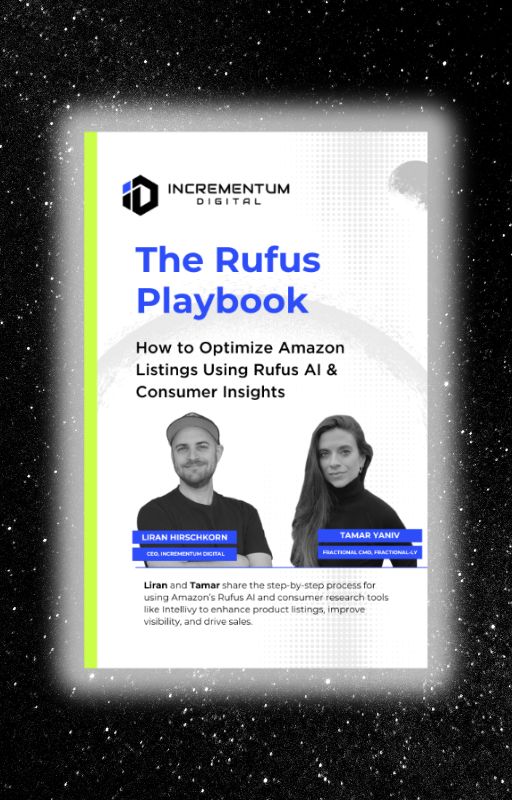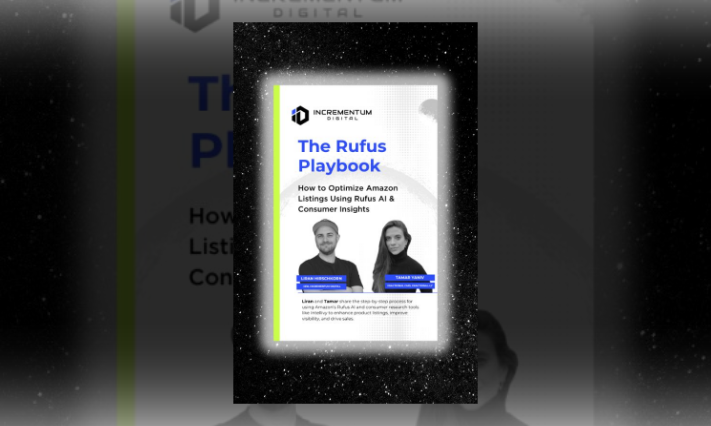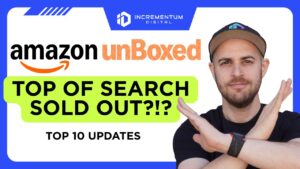Amazon Advertising
Amazon Prime Big Deal Days 2025: The Q4 Seller’s Guide

If Prime Day drives hype, Amazon Prime Big Deal Days drives Q4 decisions. After all, it’s the last major shopping window before the chaos of Black Friday and Cyber Monday, and for sellers and brands facing a compressed holiday calendar and unpredictable post-election behavior, it offers a critical moment to generate sales under controlled conditions. With Thanksgiving landing late (November 27), there are only three full weekends to hit your holiday numbers. Combine that with rising CPCs, limited warehouse space, and tighter consumer budgets, and the margin for error gets smaller by the week.

Learn How to Make Listings That Convert in 2025!
Read our step-by-step guide on how to optimize your listings using Rufus AI insights. Sign up for our newsletter and get your copy for free!
Show me howThat’s why October matters more than ever. Prime Big Deal Days gives you a rare window to capture demand early, optimize inventory flow, and fine-tune ad performance, all before the real Q4 pressure hits.
What’s at Risk this Q4 2025
With Thanksgiving falling on November 27, brands are left with just three full weekends to hit their Q4 numbers before Christmas. That’s a narrow window, especially when you factor in shipping cutoffs, fulfillment congestion, and limited promo flexibility.
Meanwhile, consumer behavior is changing in visible ways. U.S. online holiday sales are forecast to grow just 2.1% this season, compared with about 4% last year. Shoppers are becoming more value‑focused: gift spending is expected to drop 11%, and overall holiday spend per person is down by roughly 5%. Approximately 84% of consumers plan to reduce spending in the coming months, and Gen Z budgets are falling fastest, with an expected 23% cutback.
Amazon adds to the pressure starting October 15, when holiday peak fulfillment fees kick in across key categories. Rates jump significantly during Q4, with some categories seeing a 207% increase in per-unit storage fees, from $0.78 to $2.40 per cubic foot. That means brands sitting on slow-moving or bulky inventory will see margin erosion just as peak traffic ramps up.
There’s some margin stability: Amazon has confirmed that core U.S. referral and FBA fulfillment fees are not increasing in 2025, giving brands a bit more predictability in base operating costs.
New Competitive Fire: Walmart Deals (Oct 7–12)
Walmart just announced its own multi‑day holiday event: Walmart Deals, running from October 7 at 12:00 a.m. ET through October 12, with a 5‑hour early access window for Walmart+ members starting October 6 at 7 p.m. ET.
Key differentiators:
-
Open to all shoppers, not just members.
-
Tens of thousands of deals across core categories (electronics, toys, home, décor, fashion, beauty, etc.).
-
Convenience pushed hard: same-day delivery, early‑morning drop offs (beginning at 6 a.m.), and Express delivery in as little as 30 minutes.
This isn’t just a knockoff of Prime Day; it’s a preemptive counterpunch meant to fracture consumer attention and reroute budgets ahead of Amazon’s Big Deal Days.
Implications
-
Prime Big Deal Days no longer exist in a vacuum. Walmart’s event will compete directly for early holiday dollars, diluting the window of opportunity.
-
Brands must decide whether to double-down early on Amazon, or diversify media budgets into Walmart during that overlapping stretch.
-
Inventory management becomes even more critical: you don’t want to be over‑committed to capacity on Amazon while missing momentum on Walmart (or vice versa).
-
Your media calendar needs guardrails: don’t let Walmart outspend or out-hype you during Oct 7–12.
-
A preloaded snapback strategy is essential: immediately reallocating toward the winner (Amazon or Walmart) once real-time performance emerges.
Why Amazon Prime Big Deal Days Is Your Q4 Control Panel
Prime Big Deal Days (Oct 7–8, 2025 in the U.S.) may be one of the last windows this year where your decisions still carry leverage. With the event officially announced by Amazon as the kickoff to the fall shopping season, brands have a chance to make strategic moves before Q4 gets fully crowded.
Timing Advantage: Because Prime Big Deal Days comes in early October, you get a relatively calmer environment compared to the weeks leading up to Black Friday. That means fewer overlapping promotions, less inventory stress, and more breathing room to test messaging or offers before ad costs and consumer expectations ramp up. The official Amazon announcement confirms the dates and that Prime membership will be required to access deals.
Inventory Optimization: This period is ideal for moving inventory that risks being stale or costly. Because the holiday peak fulfillment fees apply later in the season and spots in FBA fill up, using this event to reduce slow-moving or seasonal SKUs can help reduce fees, improve cash flow, and protect warehouse margins. Brands that lean too heavily into discounting their core SKUs too early may find themselves squeezed when demand shifts. (Amazon’s deal announcements make clear that early deals are being made available for certain categories in advance of the Oct 7‑8 window.)
Funnel Testing Opportunity: Since this is one of the first big shopping events in Q4, it allows you to test what works: audiences, creative, pricing, placement.
For example, you can test ad creative aimed at gift seekers, or different bundling approaches, without the full noise of Cyber Week.
Also, since Prime Big Deal Days is announced well in advance, your brand’s early signals (clicks, conversions, top search placements) will feed directly into how you allocate budget for November and December. (Amazon is promoting early deals and highlighting highly discounted items ahead of the official days, which helps with early signal‑gathering.)
Demand Signals: The performance during Prime Big Deal Days can be a barometer for what customers want this season. What categories are moving? What price points are resonating? What creative is converting? Those are insights you can use to forecast demand for the rest of Q4.
With Amazon explicitly marketing deals from categories like home, apparel, toys, electronics, and beauty in early announcements, you’ll get visibility into what people are browsing and buying ahead of the crush.
Tactical Moves to Make Right Now
To get the most out of Amazon Prime Big Deal Days, you need more than a deal sheet and a few sponsored ads. These are the tactical decisions that will separate brands playing offense from those reacting late in Q4.
1. Start with strategic discounting.
This is not the time to throw discounts across your entire catalog. Focus on clearing out slower-moving SKUs, seasonal items that will lose relevance after October, or products where storage fees are eating into margins. Keep the discount range intentional, ideally between 15 to 30 percent, depending on inventory pressure. This allows you to drive volume without compromising profitability.
2. Sequence your inventory with intent.
Your best sellers should be protected, not thrown into early discounts. Hold them for the Cyber 5 window when demand and conversion rates spike. Use Prime Big Deal Days to create lift elsewhere in your catalog, while preserving your most profitable ASINs for moments when they’ll earn more per unit sold.
3. Layer your funnel activity.
This event is your last chance to test creative, refine audience targeting, and re-engage high-intent shoppers before Q4 peaks. Use DSP to retarget visitors from July’s Prime Day, reach cold gift shoppers, and test messaging frameworks designed for holiday intent. The data you gather here will fuel smarter decisions for Black Friday and beyond.
4. Differentiate your Canada and U.S. strategy.
How long is Amazon Prime Big Deal Days? Well, the U.S. gets 48 hours, while Canada gets 96 hours (October 7-11), and that’s not a minor detail. Treat them like two separate campaigns. Use the extended window in Canada to test pacing, creative variations, and discount thresholds that can inform your U.S. execution. Brands that use this split strategically will gather better insights and drive more efficient results.
For the insights we gained from the 4-day Prime Day, check out our blog post here.
The Payoff for Amazon Prime Big Deal Days
If executed right, Prime Big Deal Days becomes more than just an early sales bump. It sets the stage for a more profitable, less chaotic Q4. You get better margin control by moving slow inventory without over-discounting your best sellers. You improve inventory velocity by aligning supply with demand before warehouse fees and stockouts become problems. And most importantly, you make the rest of the quarter more predictable, because you’ve already tested your funnel, moved inventory strategically, and pulled forward some of the pressure that would otherwise hit all at once during Cyber Week.
This is how high-performing brands create separation; not by playing catch-up in November, but by using October to execute with precision.
Q4 is challenging for every brand: tighter timelines, rising ad costs, and operational bottlenecks all come to a head in just a few short weeks. Planning ahead isn’t about getting a head start for the sake of it. It’s about making better decisions with fewer surprises when the stakes are highest.
Looking for a deeper breakdown of Q4 strategies that still apply?
Check out our BFCM 2024 performance recap for actionable insights on inventory planning, budget pacing, and campaign execution that hold up well ahead of Prime Big Deal Days 2025.
If you want a second set of eyes on your Q4 strategy or just need clarity on where to focus, contact our team. No pitch, just a conversation focused on what’s most important for your brand.
LET’S DISCOVER WHAT’S POSSIBLE FOR YOUR BRAND
We’re here to listen and uncover opportunities tailored to your unique goals.
Fill out the form to get started, and you’ll walk away with real insights and actionable recommendations—whether we work together or not.
- HANDS-ON LEADERSHIP
- AWARD-WINNING PARTNERSHIPS
- CUSTOM-BUILT SOLUTIONS




